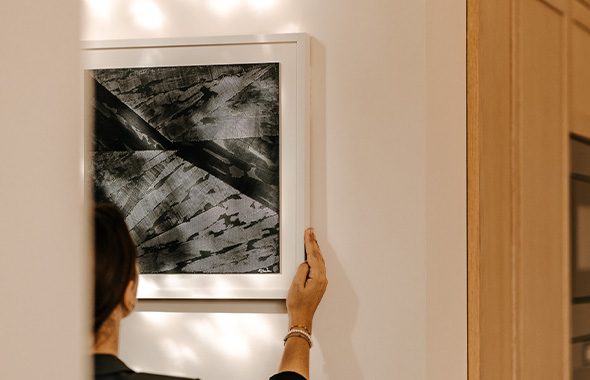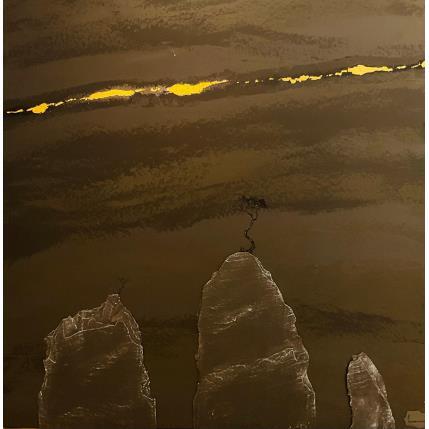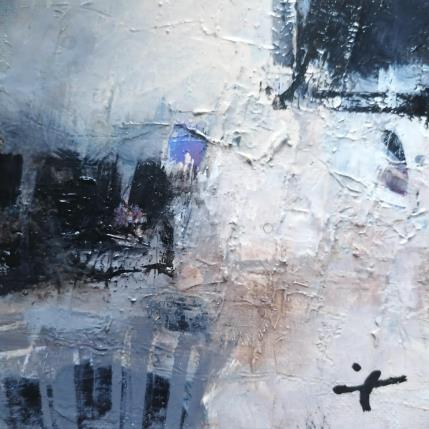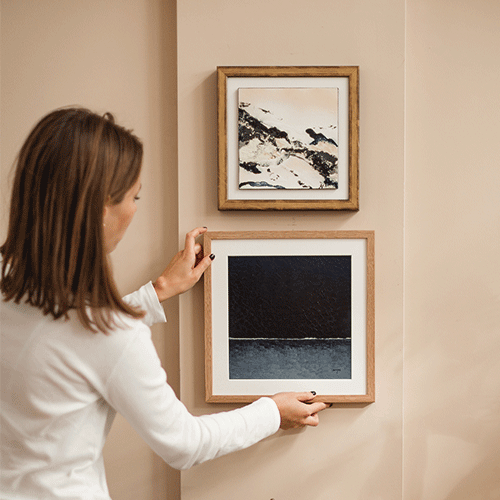Read more
The Growing Trend of Black Wall Decor
Using black painting for home decoration is becoming increasingly popular, as it brings a touch of sophistication to any space. More practical than wallpaper, black wall decor entices many interior decoration enthusiasts.
Dark colors and the unique textures of black art pieces draw attention and can be used to create a focal point on a blank wall or add depth to an already decorated space.
Furthermore, black art pieces are highly versatile and can blend with numerous different decoration styles, ranging from modern to traditional (industrial, minimalist, contemporary, Scandinavian, etc.) They can also seamlessly integrate into various settings, such as workspaces, bedrooms, bathrooms, hence the trend for black bathroom decor, and living rooms.
Art enthusiasts who appreciate dark colors and unique textures will also find that black artworks are an excellent choice for their decor and passion. Besides their aesthetic contribution, black art creations are also considered a durable investment, as they can remain fashionable and relevant for many years.
In essence, the growing use of black wall decor in homes is due to its ability to add a touch of sophistication to any space, as well as its versatility and durability.
The Advantages of Black Decor with Artwork
Atmosphere: Black can bring a touch of sophistication to any space, especially when used in combination with other bright or lighter colors. Black pairs wonderfully with wood. Wall art is perfect to personalize your home decor.
Contrast: Black can add contrast and depth to a room, making lighter colors and textures stand out.
Versatility: Black is highly versatile and can blend with many different decoration styles, ranging from modern to traditional.
Durability: Black decorative items and artwork are often considered durable and can remain relevant for many years.
Intimacy: Black can add an intimate and comfortable ambiance to a room, making it more welcoming and inviting.
How to Choose the Right Black Artworks?
Consider the dimensions and placement of the artwork
When it comes to considering the dimensions and placement of a piece of art, it is important to take into account the following factors:
Room size: It is essential to consider the size of the room in which you want to hang the artwork. Larger pieces of art are more suitable in spacious rooms, while smaller ones fit better in smaller rooms.
Lighting: It is also vital to consider the room's light source. Art can be influenced by the amount of natural and artificial light surrounding it, so it is important to place it somewhere that allows it to shine.
Mounting height: The height at which you want to hang the art piece is important to consider. Larger artworks are often better showcased when hung at a higher height, while smaller pieces can be hung lower.
Decoration style: The style of the room's decor is an important consideration when choosing the placement of the artwork. An artwork can be used to reinforce the decor style of a room or add a contrasting touch.
Other decor elements: Consider other decor elements in the room, such as furniture, rugs, curtains, etc
Assessing Style and Technique to Harmonize with the Rest of the Decor
When assessing the style and technique of a painting to harmonize with the rest of your decor, it's crucial to consider the following factors:
- Style: The painting's style and your overall decor style need to align. A painting with rich colors and detailed elements will harmonize well with a traditional interior, while a painting with simple colors and clean lines would suit a modern interior better.
Color: Color is a crucial factor when evaluating a painting's style and technique. You need to choose colors that harmonize with your existing decor and won't overwhelm it.
Technique: The technique used to create the painting is also a critical factor. An abstract work can harmonize with a more modern decor, while a more classical work, like an oil painting, might blend better with traditional decor.
Texture: A painting's texture can also influence its harmony with your existing decor. Rough-textured paintings can add an additional visual interest, while smooth-textured paintings can introduce a sense of calm and simplicity.
Theme: The painting's theme should align with your decor's overall theme. If your decor has a natural theme, a painting featuring natural images may harmonize well with it.
Ultimately, the harmony between a painting and the rest of your decor depends on how well they work together to create a coherent and aesthetic environment. It's important to account for style, color, technique, texture, and theme when evaluating how a painting might harmonize with your existing decor.
How to Incorporate Black Artwork into Your Decor
A touch of black can give relief to decor. Here's how to integrate it effectively:
- Use black frames: By using black frames to frame your paintings, you can create a uniform and coherent look in your living space.
- Use in a dark-colored space: If you have a living space painted in dark color, you can use black artworks to add a touch of sophistication and intensity.
- Highlight with lights: Using targeted lighting, you can highlight the painting's details and make them stand out in your decor.
- Showcase with other artworks: Black artworks can be showcased by pairing them with artworks of different colors. This can add a touch of diversity and contrast to your decor.
It's crucial to consider the available space and ensure that black artworks harmonize with the existing decor style. Black artworks can be used to create a formal or serious ambiance, or add an intensity touch to a room.
Combining Black with Other Colors
Black artworks can be combined with other colors to create an aesthetic and harmonious look. Here's how:
- Pair with light colors: Black artworks can be paired with light colors like white, beige, or gray to add a contrasting touch and balance the color palette
- Use complementary colors: Complementary colors such as green and red, or yellow and blue, can be used to create a dynamic and interesting look when combined with black artworks.
- Associate with warm colors: Warm colors like yellow, orange, and red can add a touch of warmth and energy to a space decorated with black artworks.
- Use soft colors: Soft colors like pale pink and pale blue can add a touch of softness and calm to a space deIntegrate bright colors: Bright colors like vivid green, vivid blue, and vivid red can add a touch of brilliance and energy to a space decorated with black artworks.
It's essential to consider the ambiance you want to create in your space and choose colors accordingly. By using a coherent color palette and avoiding overly saturated or contrasting colors, you can create an attractive and harmonious look. Discover all the paintings by color.
Black as the Focal Point for Wall Decor
Black artworks can be used to emphasize an empty wall and make it an attractive focal point. Here are our tips:
- Artwork Size: To create a strong focal point, it's crucial to select a sizable piece of art. If you have a large empty wall, a large artwork will be particularly effective.
- Location: Place the artwork in the middle of the wall or slightly above the center so that it's visible from all angles of the room.
- Lighting: It's important to illuminate the artwork correctly to highlight it. You can use direct lighting, like a floor lamp or a spotlight, to illuminate the artwork in the evening
- Framing: If you wish, you can frame the artwork to make it stand out more and add a touch of sophistication to your decor.
- Surroundings: Surround the artwork with complementary colors and textures to enhance its impact. You can also add decorative elements like shelves, mirrors, or art objects to create a consistent and pleasing look.
- By using these tips, you can use black artworks to highlight an empty wall and create an interesting focal point in your living space.
For even more advice and tasteful decor, check out our free guide!!





































